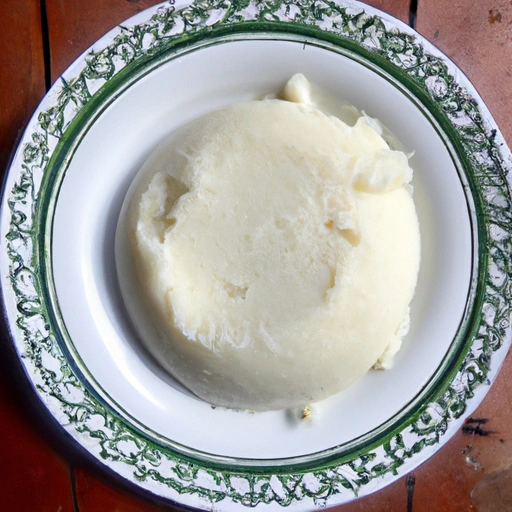Ugali
Authentic Ugali Recipe from Tanzania - Made with Cornmeal and Milk
Introduction

Ugali is a popular dish in many African countries, particularly in Kenya and Tanzania. It is a simple yet delicious staple made from white cornmeal and water, often served as a side dish with meat, vegetables, or stew.
History
Ugali has been a traditional dish in East Africa for centuries, dating back to when corn was introduced to the region by Portuguese traders. It quickly became a staple food due to its affordability and versatility.
Ingredients
How to prepare
- Boil the water in a saucepan with added salt.
- In a separate bowl, combine the milk and white cornmeal.
- Stir the mixture until it becomes smooth.
- Gradually pour the cornmeal mixture into the boiling salted water.
- Continuously stir the mixture for a few minutes until it thickens.
- Reduce the heat to low and cook the ugali for approximately 10 - 15 minutes.
- Stir the ugali every few minutes.
- Continue cooking and stirring until the ugali becomes very stiff, thick, and pulls away from the sides of the saucepan.
Variations
- Add a tablespoon of butter or margarine for a richer flavor.
- Use coconut milk instead of regular milk for a tropical twist.
- Mix in grated cheese for a cheesy ugali variation.
Cooking Tips & Tricks
Use a heavy-bottomed saucepan to prevent the ugali from sticking to the bottom.
- Stir the mixture continuously to avoid lumps forming.
- Adjust the amount of water or cornmeal to achieve the desired consistency.
Serving Suggestions
Ugali is traditionally served with sukuma wiki (collard greens), nyama choma (grilled meat), or stewed vegetables.
Cooking Techniques
Cook the ugali on low heat and stir continuously to prevent burning and ensure a smooth texture.
Ingredient Substitutions
Use yellow cornmeal instead of white for a slightly different flavor.
- Substitute water with chicken or vegetable broth for added flavor.
Make Ahead Tips
Ugali can be made ahead of time and reheated before serving. Store in an airtight container in the refrigerator for up to 2 days.
Presentation Ideas
Shape the ugali into a mound or serve it in a bowl for a more visually appealing presentation.
Pairing Recommendations
Serve ugali with grilled fish, roasted vegetables, or a spicy curry for a delicious and satisfying meal.
Storage and Reheating Instructions
Store leftover ugali in the refrigerator and reheat in the microwave or on the stovetop with a splash of water to prevent drying out.
Nutrition Information
Calories per serving
A serving of ugali typically contains around 200-250 calories, depending on the portion size and ingredients used.
Carbohydrates
Ugali is a high-carbohydrate dish, providing a good source of energy for the body.
Fats
Ugali is low in fats, making it a healthy option for those watching their fat intake.
Proteins
Ugali is not a significant source of protein, so it is often served with protein-rich dishes such as meat or beans.
Vitamins and minerals
Ugali is rich in essential vitamins and minerals, particularly vitamin B and iron from the cornmeal.
Alergens
Ugali is gluten-free and suitable for those with gluten allergies or sensitivities.
Summary
Ugali is a nutritious and filling dish that is low in fats and high in carbohydrates, making it a healthy option for a balanced diet.
Summary
Ugali is a versatile and nutritious dish that is easy to make and pairs well with a variety of dishes. Whether served as a side or main course, it is sure to satisfy and nourish.
How did I get this recipe?
:
I distinctly remember the first time I saw this recipe for Ugali. It was many years ago, back when I was just a young girl living in a small village in Kenya. My grandmother, who was known for her incredible cooking skills, had invited me into the kitchen to help her prepare our family's favorite meal.
As I watched her expertly mix the maize flour with boiling water, I couldn't help but be amazed by her precision and skill. She explained to me that Ugali was a staple food in our culture, made from simple ingredients but packed with flavor and tradition.
Over time, I watched and learned as my grandmother cooked Ugali time and time again. She taught me the importance of patience and attention to detail, reminding me that the key to a perfect dish lies in the little things - the right amount of water, the perfect consistency, the careful stirring.
As I grew older, I began to experiment with the recipe on my own, adding my own twists and flavors to make it my own. I would spend hours in the kitchen, perfecting my technique and trying out new ingredients to see how they would affect the final product.
Through years of trial and error, I eventually developed my own signature Ugali recipe - a blend of traditional flavors and modern influences that never failed to impress my family and friends. I was proud to carry on the tradition of Ugali-making, knowing that I was honoring my grandmother's legacy and preserving a piece of my cultural heritage.
To this day, Ugali remains one of my favorite dishes to cook. Whenever I make it, I am transported back to those early days in my grandmother's kitchen, watching her work her magic and feeling a sense of connection to my roots and my family.
As I pass down my recipe for Ugali to future generations, I hope that they too will come to appreciate the simple beauty and deliciousness of this dish. It may just be a humble cornmeal porridge, but to me, it is a symbol of love, tradition, and the enduring power of food to bring people together.